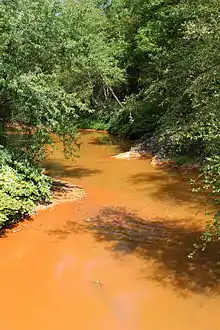Abandoned mine drainage
Abandoned mine drainage (also known as AMD[1]) is a form of water pollution involving water that has been polluted by contact with mines, typically coal mines.[2] Although it is sometimes called "acid mine drainage", not all abandoned mine drainage is acidic.[3][4]

Types
The most common form of abandoned mine drainage is acid mine drainage, which is highly acidic water coming from mines.[2] Abandoned mine drainage can become acidic when it is exposed to oxygen and sulfur-containing minerals such as pyrite.[5]
Another form of abandoned mine drainage is alkaline mine drainage.[2] This typically occurs in the presence of minerals such as calcite, limestone, or dolomite.[2][6] The third form of abandoned mine drainage is metal mine drainage, which occurs when large amounts of metals such as lead contaminate mine water.[2]
Geochemistry
The precise chemistry of abandoned mine drainage discharges typically varies.[4] Abandoned mine drainage typically originates in surface mines, deep mines, and "gob piles".[6]
Abandoned mine drainage typically has high concentrations of metals and total dissolved solids.[5] Iron is the most common metal in abandoned mine drainage, but aluminum and manganese occur as well.[3] It may also have a high water temperature and an altered pH, though the characteristics of abandoned mine drainage depend heavily on the area's geochemistry.[5] Other signs of abandoned mine drainage include high sulfate levels and siltation.[3] Acid mine drainage has a pH of less than 7, while alkaline mine drainage has a pH of greater than 7.[1]
The concentrations of metals in abandoned mine drainage can range from several to several thousand parts per million. In Pennsylvania's Coal Region, it has an iron concentration of less than 100 milligrams per liter (0.100 oz/cu ft) and a pH of close to 7.[1]
Abandoned mine drainage can cause affected streams to take on a bright orange color.[7]
Environmental effects
Abandoned mine drainage affects streams worldwide.[8] A 2017 United Nations Environmental Programme (UNEP) report documented "widespread destruction" from mining waste that is released into the environment as a result of dam failures.[9]
Mine drainage is prevalent in the United States state of Pennsylvania, as well as several other states that have historically had large mining industries.[2] In Pennsylvania, nearly 2,500 miles (4,000 km) of streams have been affected by abandoned mine drainage, and more than 7,500 miles (12,100 km) have been affected in the Appalachian Mountains, and more than 10,000 miles (16,000 km) are affected in Pennsylvania and West Virginia.[10][3][7]
In one watershed affected by abandoned mine drainage, the value of homes within 200 feet (61 m) of an affected stream decreased by $2500 per 1 acre (0.40 ha), as of 2009.[3]
Algae sometimes coat streams that are affected by abandoned mine drainage, although aquatic plants have difficulty surviving in such streams. The gills of fish are also harmed by the metals in abandoned mine drainage. The eggs of macroinvertebrates and fish are also smothered by the precipitate. Coldwater fish such as trout are especially harmed by abandoned mine drainage.[3]
Abandoned mine drainage also affects the plants and animals in the area surrounding the mine. Mine drainage pollution has been found in sheep that fed near abandoned mines. [11]
Remedies and applications
There are several methods by which abandoned mine drainage can be remedied: passive treatment, active treatment, and land reclamation.[3] Trompes may also be useful in treating abandoned mine drainage.[12]
The natural gas industry has suggested using abandoned mine drainage water in hydraulic fracturing.[13] Proponents of this idea say that it would remove toxic water from the environment while reducing the natural gas industry's need to use water from streams and rivers. However, opponents have said that it would "make a dirty process even dirtier". This has already been done with streams such as an unnamed tributary to Johnson Creek.[14] Abandoned mine drainage solids have shown potential in capturing mercury emissions from coal-fired power plants.[15]
The iron oxide generated by treating abandoned mine drainage can be used as a glaze for pottery.[16]
References
- Eastern Pennsylvania Coalition for Abandoned Mine Restoration, AMD-Abandoned Mine Drainage, retrieved September 24, 2015
- United States Environmental Protection Agency, Abandoned Mine Drainage, retrieved September 24, 2015
- Trout Unlimited, Abandoned Mine Drainage – Trout in the Classroom, pp. 2, 4–6, archived from the original on September 25, 2015, retrieved September 24, 2015
- Abandoned Mine Drainage Basics, Abandoned Mine Reclamation Clearinghouse, retrieved September 24, 2015
- United States Environmental Protection Agency (August 2000), Abandoned Mine Site Characterization and Cleanup Handbook (PDF), p. 17, retrieved September 24, 2015
- Fayette County Conservation District, Abandoned mine drainage, retrieved September 24, 2015
- Trout Unlimited, Eastern Abandoned Mines Program, retrieved September 24, 2015
- Metal Removal from Mine Drainage Water, 2014, retrieved September 24, 2015
- Olivares, Jose (December 2, 2017). "U.N. Body Alarmed Over Mining Waste Disasters". NPR.org. Retrieved 2017-12-16.
- Christopher Woltemade (2011), Abandoned mine drainage impacts on pH in Shamokin Creek, Pennsylvania, archived from the original on March 4, 2016, retrieved September 24, 2015
- Pareja-Carrera, J., Mateo, R., & Rodríguez-Estival, J. (2014). Lead (Pb) in sheep exposed to mining pollution: Implications for animal and human health. Ecotoxicology and Environmental Safety, 108, 210–216. http://doi.org/10.1016/j.ecoenv.2014.07.014
- Don Hopey (June 24, 2013), "A 16th-century method may revolutionize mine drainage treatment", Pittsburgh Post-Gazette, retrieved September 24, 2015
- Joe Massaro (March 23, 2013), "Abandoned Mine Drainage Use in HF is a Win-Win", energyindepth.org, retrieved September 24, 2015
- Susan Phillips (March 12, 2013), Using Abandoned Mine Drainage to Frack, National Public Radio, retrieved September 24, 2015
- Wei Sun (2009), Use of abandoned mine drainage solids for the control of mercury emissions from coal-fired power plants (Master's Thesis), University of Pittsburgh, retrieved September 24, 2015
- Jared Kline, Jessica Lily (June 13, 2015), Concord Professor Uses Acid Mine Drainage for Pottery, West Virginia Public Broadcasting, retrieved September 24, 2015